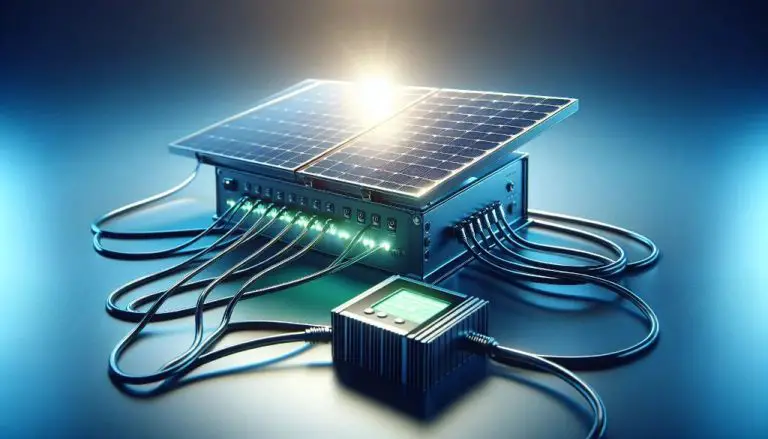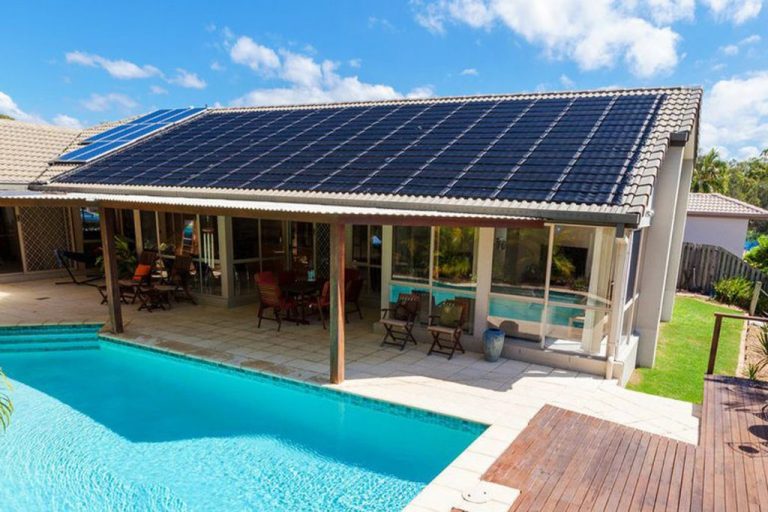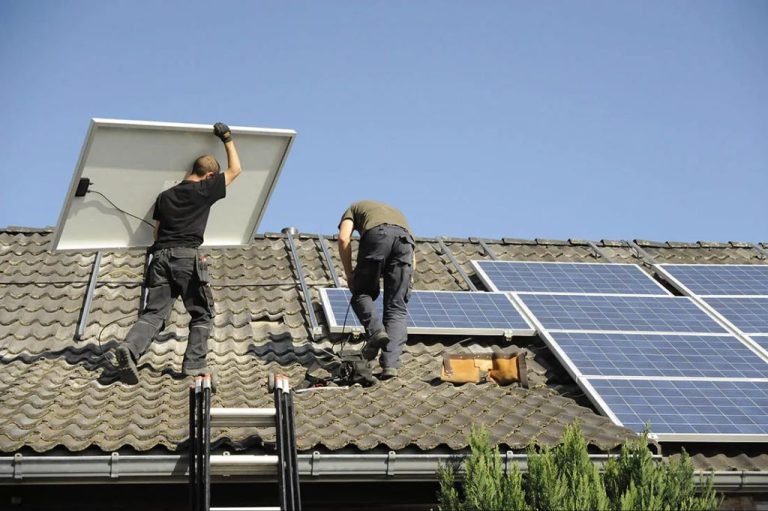How Many Solar Panels Needed To Power A House?
With over 3% of U.S. homes now using solar panels, an increasing number of homeowners are looking to solar energy to help power their homes. Solar panels convert sunlight into electricity, allowing homes to reduce their reliance on the grid. The number of solar panels needed to power a home depends on several factors, including the home’s energy use, the panels’ wattage, sun exposure, and energy efficiency. This article provides an overview of how to determine the number of solar panels required to meet a home’s electricity needs.
Average Home Energy Use
The average home in the United States uses about 900 kWh of electricity per month. This can vary based on factors like home size, appliances used, heating sources, and climate, but 900 kWh is a reasonable estimate for the typical home’s monthly energy needs (http://hornacek.coa.edu/dave/Teaching/Energy.F23/pdf/solar_PV_F23.a.pdf).
According to the U.S. Energy Information Administration, the average monthly electricity consumption for U.S. homes is 893 kWh. This is based on data from 2015 showing an average annual electricity consumption of 10,712 kWh per household (https://www.ncbi.nlm.nih.gov/pmc/articles/PMC7904108/).
Knowing a home’s average energy use per month in kWh is important for properly sizing a solar panel system to meet that energy demand.
Solar Panel Output
The amount of power that a solar panel can produce is measured in watts. Most residential solar panels today have power ratings between 250-400 watts.[1] On average, a standard 350 watt solar panel can produce about 350 watts under ideal conditions.[2] This number represents the panel’s peak production capacity.
In real-world conditions, solar panels rarely operate at their full rated wattage. Factors like shading, cloud cover, and the angle of the sun throughout the day reduce the amount of energy produced. A 350W panel in a typical residential installation will average around 250-300 watts per hour of direct sunlight over the course of a day.
To determine the kWh energy output for a solar panel, you multiply the rated wattage by the average number of peak sunlight hours for your location. For example, if you get 4 peak sunlight hours per day, that 350W panel would produce around 1.4 kWh of energy (350W x 4 hrs = 1,400 Wh or 1.4 kWh).
When calculating solar production, it’s important to use the average peak sun hours for your specific area. The number of sunlight hours varies significantly depending on location and local weather patterns.[1]
[1] https://www.marketwatch.com/guides/solar/solar-panel-wattage/
[2] https://www.energysage.com/solar/solar-panel-output/
Solar Panel Size
The size of solar panels used in residential installations typically ranges from 60 to 72 cells. Standard dimensions for 60-cell panels are approximately 39-40 inches wide by 64-65 inches long. 72-cell panels are a bit larger at around 46-47 inches wide and 77-78 inches long.
Most residential systems today use 60-cell and 72-cell panels in the 250 to 400 watt range. Going with larger, higher wattage panels means you need fewer of them to meet your energy needs. The trade-off is that larger panels can be more difficult to install on some roof types and require stronger mounting equipment.
When determining what size solar panels to get, some key factors to consider are roof space, local solar incentives that limit system size, energy efficiency needs, and aesthetics. Your solar installer will help determine the optimal panel size and system design for your home.
Orientation and Tilt
The optimal direction and tilt for solar panels depends on your location. In the Northern hemisphere, solar panels should face true south for maximum sunlight exposure. Panels facing south receive direct sunlight throughout the day as the sun travels from east to west across the southern sky.
The ideal tilt angle for solar panels is between 15-40 degrees in the continental U.S., with steeper angles needed as you go further north. According to Energysage, south-facing panels tilted 15-40 degrees perform best across most of the country [1]. For example, 30-45 degree tilt angles are recommended in northern states like Minnesota and Maine to optimize winter sun capture. Tilting panels at these steeper angles helps maximize production during seasons when the sun sits lower in the southern sky.
Proper orientation and tilt ensures your solar array captures the most sunlight throughout the year. Facing solar panels south and angling them based on latitude are key considerations during installation for optimal energy production.
Shading and Obstructions
Shading can significantly reduce the energy output of solar panels. When solar cells are shaded, even partially, their ability to generate electricity decreases. This is because PV solar panels work by converting photons from sunlight into electricity. If a panel is shaded, fewer photons reach the solar cells and less energy is produced.
According to research, just a small 10% shaded area on a solar panel can reduce power output by as much as 54%. The impact depends on the extent of shading and which cells are affected. Even minor shading from objects like trees, chimneys, or poles can have a substantial effect on solar panel productivity and efficiency.
To maximize solar panel efficiency, installers should carefully analyze the site and minimize any potential obstructions that could cast shadows on the panels. Software tools like sun path calculations can help determine the impact of shading over the year.
Local Weather and Sunlight
The amount of sunlight and solar energy available in an area heavily impacts how much electricity solar panels can produce. Areas that receive more annual sunlight and have sunnier weather will generate more solar power. According to Sun Hours Map: How Many Sun Hours Do You Get?, parts of the Southwest United States average over 6 peak sun hours per day, while the Pacific Northwest only sees around 3-4 peak sun hours per day. Peak sun hours refer to the equivalent number of hours per day when solar irradiance averages 1000 watts per square meter.
Areas like Arizona and New Mexico have many cloudless days per year and high levels of solar insolation. This enables solar panels to operate at peak capacity for more hours during the day. In contrast, locations with more rainy and cloudy weather will experience reduced solar panel output on those days. However, modern solar panels can still generate electricity even on cloudy days. The key factors are the total annual sunlight hours and the number of peak sun hours for a geographic area.
According to Peak Sun Hours: Explanation and Numbers By State, Arizona averages 5.91 peak sun hours per day while Alaska only sees 3.4 hours on average. Even within a state there can be significant variation based on local climate patterns. Evaluating the solar resource for your specific location will determine how productive solar panels can be.
Energy Efficiency
Reducing your home’s energy use through efficiency and conservation measures is key to right-sizing a solar panel system. Energy efficient appliances, lighting, and HVAC systems, as well as good insulation, air sealing, and energy conservation practices allow you to get by with fewer solar panels. By maximizing efficiency first, you can install a smaller solar array to meet your reduced energy needs.
Switching to ENERGY STAR certified heating, cooling, appliances, electronics, and lighting can significantly cut electricity use. Simple behavioral changes like turning off lights, adjusting the thermostat, using efficient laundry and dishwasher settings, and unplugging unused devices also reduce waste. Strategic upgrades like insulation, high-efficiency windows, and air sealing further diminish energy demands. Applying efficiency measures first, before solar, is the most cost-effective way to right-size your system.
Battery Storage
Homeowners with solar panels often pair them with battery storage to capture and hold any extra energy produced (Energy.gov). Batteries allow solar panel owners to store surplus solar energy captured during the day for use at night when solar can’t produce energy (Sunnysolarpower.com). This provides households with clean energy even when the sun isn’t shining.
Popular home battery options like the Tesla Powerwall allow solar panel owners to save excess solar energy in a high-capacity lithium-ion battery pack (Zeconex.com). The Powerwall battery can store between 5-10 kWh of energy. This gives homeowners with solar panels the ability to use their own stored solar energy to provide power when solar production drops off, such as overnight and during grid outages or blackouts. Battery storage paired with solar panels makes homes more energy independent.
Number of Panels Needed
The number of solar panels needed to power a house depends on several factors, including the home’s energy usage, the power output of the panels, and the available sunlight in the area. Here is the basic formula for calculating how many solar panels you need:
Annual kWh usage ÷ Panel output (kWh) ÷ Hours of sun per day = Number of panels
Let’s break this down into steps:
- Calculate your home’s annual electricity usage in kWh. Look at past utility bills to estimate usage.
- Determine the solar panel power output in watts. For example, a 300W panel.
- Convert the panel wattage to kWh by multiplying by the number of peak sun hours for your location. For 300W, 6 sun hours = 1,800 kWh per year.
- Divide your annual usage by the annual solar panel production to get the number of panels needed.
Keep in mind that energy efficiency measures like LED lights and upgraded appliances will reduce the number of panels required. It’s also smart to add a buffer of 10-20% more panels than your calculation to allow for future energy needs and occasional shading.
There are also solar panel calculators online that can provide an estimate based on your location and home details (1). But this gives a general guideline for determining how many solar panels are needed to fully power a home.





